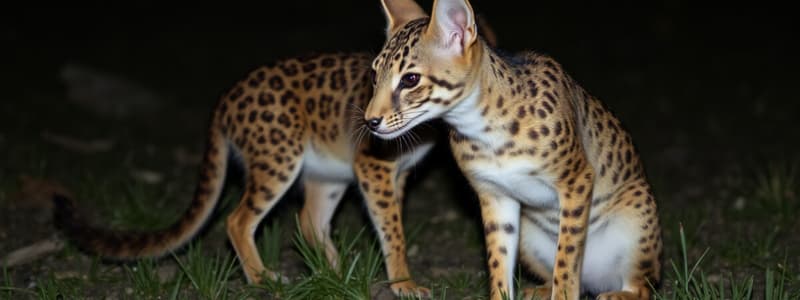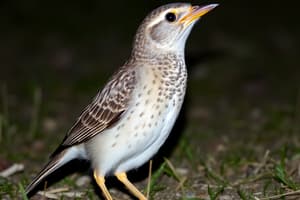Podcast
Questions and Answers
Why do most nocturnal animals sleep during the day?
Why do most nocturnal animals sleep during the day?
- To avoid predators active during the day (correct)
- To conserve energy for the night
- To socialize with other nocturnal animals
- To find food more easily
What adaptation helps nocturnal animals see better in the dark?
What adaptation helps nocturnal animals see better in the dark?
- Highly developed olfactory senses
- The ability to generate light
- Eye cells called rods (correct)
- Special feather lining
What is echolocation?
What is echolocation?
- A method for animals to communicate
- A way for animals to see using high-pitched sounds (correct)
- A technique to track scents in the environment
- An adaptation to avoid hot temperatures
Which of the following animals is NOT typically considered nocturnal?
Which of the following animals is NOT typically considered nocturnal?
How do the adaptations of nocturnal animals benefit them in their environment?
How do the adaptations of nocturnal animals benefit them in their environment?
Which sensory adaptation is especially important for an aardvark in locating food?
Which sensory adaptation is especially important for an aardvark in locating food?
What is the primary reason nocturnal animals live in the desert?
What is the primary reason nocturnal animals live in the desert?
Which feature of owls helps them fly quietly at night?
Which feature of owls helps them fly quietly at night?
What common behavior is shared by most nocturnal animals?
What common behavior is shared by most nocturnal animals?
What role does the sense of smell play for nocturnal animals?
What role does the sense of smell play for nocturnal animals?
Flashcards
Nocturnal Animals
Nocturnal Animals
Animals active during the night and sleeping during the day.
Predators
Predators
The reason why many nocturnal animals avoid being out during the day.
Desert Heat
Desert Heat
A major reason desert animals are nocturnal.
Adaptations
Adaptations
Signup and view all the flashcards
Rods
Rods
Signup and view all the flashcards
Smell
Smell
Signup and view all the flashcards
Hearing
Hearing
Signup and view all the flashcards
Echolocation
Echolocation
Signup and view all the flashcards
Quiet Flight
Quiet Flight
Signup and view all the flashcards
Aye-Aye
Aye-Aye
Signup and view all the flashcards
Study Notes
Nocturnal Animal Characteristics
- Nocturnal animals are active at night and sleep during the day.
- Many, but not all, are primarily active at night.
- Examples include bats, skunks, aardvarks, owls, and some sea turtles.
Reasons for Nocturnal Activity
- Avoidance of daytime predators is a major factor.
- Seeking shelter from intense daytime heat, particularly in desert environments, is another factor, such as with sea turtles.
Adaptations for Nighttime Activity
- Enhanced Senses: Nocturnal animals have highly developed senses to navigate the dark.
- Vision: Many nocturnal animals, like bats and aye-ayes, have specialized rod cells in their eyes, which improve light sensitivity.
- Smell: A keen sense of smell is crucial for detecting other animals or food sources in the dark. Examples include the aardvark's ability to locate insects.
- Hearing: Many have sensitive ears to detect sounds, locate prey, or communicate in the dark.
- Echolocation: Specialized adaptations exist for sound-based navigation. Bats use echolocation to create a "sound map" of their surroundings.
Additional Body Adaptations
- Specialized Features:
- Owl feathers aid quiet flight for hunting at night.
Studying That Suits You
Use AI to generate personalized quizzes and flashcards to suit your learning preferences.




